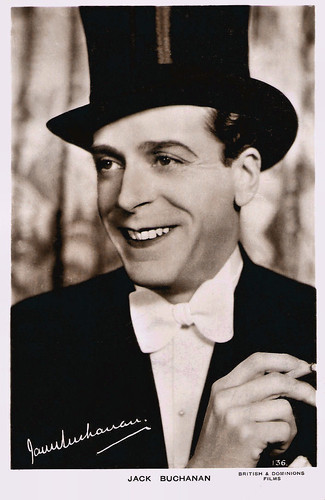
British postcard by Real Photograph, no. 136. Photo: British & Dominions Films.
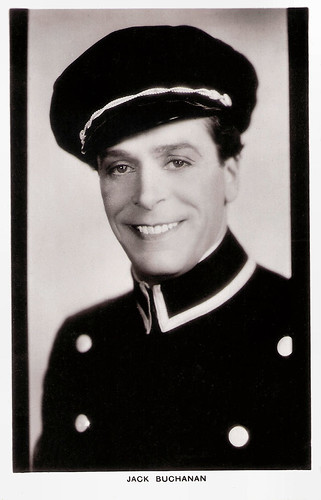
British postcard by Real Photograph in the Picturegoer Series, London, no. 630.
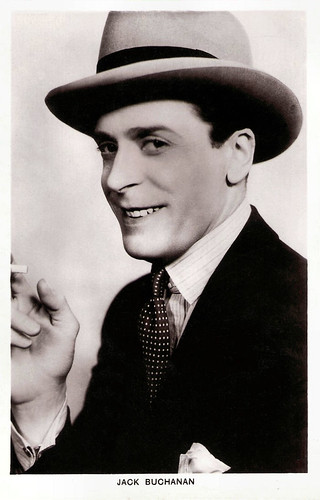
British postcard in the Picturegoer Series, London, no. 630A.
A debonair man-about-town
Walter John ‘Jack’ Buchanan was born in Helensburgh, Scotland in 1891. He was the son of the auctioneer Walter John Buchanan Sr. and his wife, Patricia, née McWatt. Jack’s father died when he was 12 and the family moved to Glasgow where Jack was sent to Glasgow Academy. After a brief attempt to follow his late father's profession and a failure at acting in Glasgow, he came to London to become a music-hall comedian.
Under the name of Chump Buchanan, he first appeared on the West End in 1912 in the comic opera 'The Grass Widow'. Hardship dogged him for a while before he became famous whilst on tour in 'Tonight's the Night'. He produced and acted in his own plays both in London and New York. Buchanan's health was not robust, and he was declared unfit for military service in World War I. He appeared with some success in West End shows during the war, attracting favourable notices as a debonair man-about-town.
Stardom came with André Charlot's revue 'A to Z' (1921), in which he appeared with Gertrude Lawrence. Among his numbers in the show was Ivor Novello's 'And Her Mother Came Too', which became Buchanan's signature song. The show transferred successfully to Broadway in 1924.
In 1926 Buchanan teamed up with Comedienne Elsie Randolph in 'Sunny'. His throwaway nonchalance was complemented superbly by her spirited vivacity. Their stage partnership was rooted in romantic comedy, but to the public, they were a romantic couple both on and off stage. For the next ten years, they starred together in a string of successes, including 'That’s a Good Girl' in which Elsie played a female detective, and Stand Up and Sing.
In a British tradition of actor management, Buchanan frequently produced his own shows. During the 1939-1945 war he starred in his own musical production 'It's Time to Dance', at the Lyric Theatre, London. In December 1930, he opened, with his partner Walter Gibbons, the Leicester Square Theatre. This venue was bombed out during the war and Buchanan lost a sizeable amount of money as a result. However, he went on to manage the Garrick Theatre in 1946.

British postcard by J. Beagles & Co., London, no. 245 M. Photo: Foulsham & Banfield.
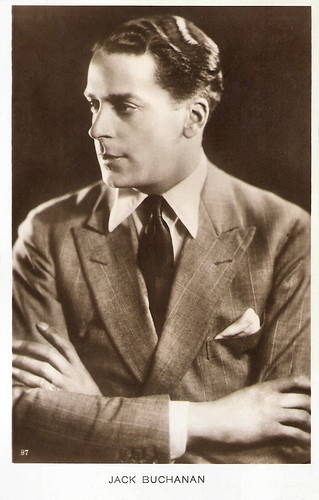
British postcard, no. 87.
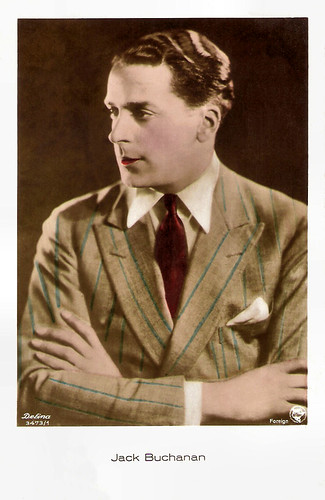
British postcard in the real hand-coloured photograph series, no. 136. Photo: Delfina / First National.
Among the top ten British stars
Jack Buchanan made his film debut in the silent cinema, in the British silent crime film Auld Lang Syne (Sidney Morgan, 1917), starring Violet Graham. Soon he played the lead role in such silent British films as the comedy The Audacious Mr. Squire (Edwin Greenwood, 1923), Bulldog Drummond’s Third Round (1925) with Buchanan as Bulldog Drummond, and the drama Confetti (Graham Cutts, 1927) with Annette Benson.
After the sound film was introduced, Buchanan moved to Hollywood. His talking debut was Paris (Clarence G. Badger, 1929), a black-and-white musical comedy film with Technicolor sequences. It was adapted from the Cole Porter Broadway musical of the same name and starred the French music-hall star Irene Bordoni. Then he starred opposite Jeanette MacDonald in Ernst Lubitsch’s musical comedy film Monte Carlo (1930). According to reviewer Wemorrow59 at IMDb, his performance was not a success: “Buchanan is given the film's most campy, embarrassing song, a paean to barbering called ‘Trimmin' the Women’, a number that looks like it escaped from the Celluloid Closet. Things get even worse later on when the plot calls for Buchanan to turn macho, and he gruffly orders Jeanette around, which is like watching Franklin Pangborn try to play a drill sergeant.”
Buchanan returned to England to star in the musical comedies A Man of Mayfair (Louis Mercanton, 1931) with Joan Barry and Warwick Ward, and Goodnight, Vienna (Herbert Wilcox, 1932) opposite Anna Neagle.
During the 1930s, he also appeared in such British films as Yes, Mr. Brown (Herbert Wilcox, 1933), Brewster's Millions (Thornton Freeland, 1935) with Lily Damita, Come Out of the Pantry (Jack Raymond, 1935) with Fay Wray, and Smash and Grab (Tim Whelan, 1937). In 1936, 1937 and 1938, British film exhibitors voted him among the top ten British stars at the box office via an annual poll in the Motion Picture Herald. In partnership with J. Arthur Rank and Charles Woolf, in 1937 he formed Jack Buchanan Productions which owned Riverside Studios in Hammersmith.
Buchanan achieved the unusual feat of starring in the London stage musical 'This'll Make You Whistle' while concurrently filming a film version in 1938. The film was released while the stage version was still running; thus the two productions competed with each other. More British films of that period were Break the News (René Clair, 1938) with Maurice Chevalier, The Gang's All Here (Thornton Freeland, 1939) with Googie Withers, and The Middle Watch (Thomas Bentley, 1940) with Greta Gynt.
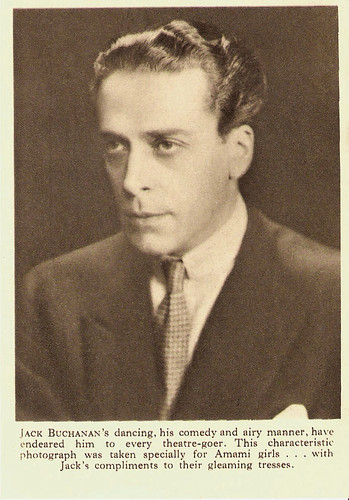
British postcard by Prichard & Constance (Manufacturing) Ltd. Makers of Amami Shampoos, London.

Vintage postcard, unknown nationality nor editor. Photo: Paramount.

Dutch-Belgian promotion card for Cacao Van Houten, no. 11 and 12. Printed by N.V. Ned Reclamefabriek. This card was part of a series of promo cards for a quiz by Van Houten Chocolate. The public had to go to stores to guess which film star was in the photo in the shop window. There were 24 photos. At the right, we recognised (with the help of a former owner of the card) Jack Buchanan and Jeanette MacDonald in Monte Carlo (Ernst Lubitsch, 1930). At left, George Bancroft and Betty Compson in The Docks of New York (1928). A Paramount picture directed by Josef von Sternberg.
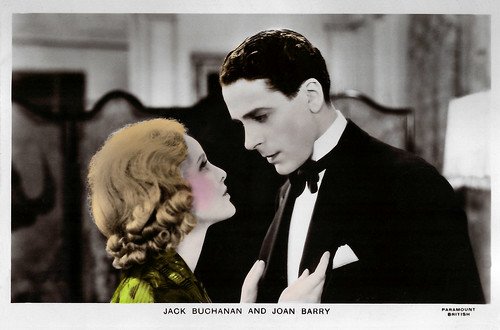
British postcard in the Film Partners Series, London, no. PC 115. Photo: Paramount British. Jack Buchanan and Joan Barry in A Man of Mayfair (Louis Mercanton, 1931).
One of MGM's most acclaimed musicals
Jack Buchanan continued to work on Broadway and the West End. In 1951 he had the unenviable task of taking over the lead in King’s Rhapsody after Ivor Novello died. Two years later, he played in his best-known film, the Hollywood musical The Band Wagon (Vincente Minnelli, 1953), in which he plays pompous stage director Jeffrey Cordova opposite Fred Astaire and Cyd Charisse. He suffered from spinal arthritis, though this didn't stop him from performing several dance numbers with Astaire in the film. Their duet, 'I Guess I'll Have To Change My Plan', and their legendary Triplets number with Nanette Fabray, made this one of MGM's most acclaimed musicals.
Later films were the British comedies As Long as They're Happy (J. Lee Thompson, 1955), and Josephine and Men (Roy Boulting, 1955) featuring Glynis Johns. He made one French film (bilingual), Les carnets du Major Thompson/The Diary of Major Thompson (Preston Sturges, 1955) with Martine Carol.
Buchanan's popularity was augmented by sales of sheet music, records, postcards, and his frequent performances on radio especially during the Second World War, including The Jack Buchanan Programme. In 1955, he performed in the hugely popular eight-part series Man About Town.
Television appearances in the USA included The Max Liebman Show and The Ed Sullivan Show. He had been at school with the pioneer of television John Logie Baird and with him co-owned Television Limited, which manufactured and rented televisions. Jack Buchanan's image was that of the raffish eternal bachelor, but he was, unknown to most, married to singer Saffo Arnau in 1915. This marriage was annulled in 1920. In 1947, he married the American Susan Bassett. He was her second husband, and through her, he had a stepdaughter, Theo, who lived with him and his wife. He had no children of his own.
Buchanan died in London in 1957 from spinal cancer, when he was 66 years old. Andrew H. Spicer commemorates him in the Oxford Dictionary of National Biography: “His limber dancing, apparently casual and spontaneous, was complemented by a slightly husky light tenor voice considered both pleasant and alluring. His whole style was especially notable for a relaxed, affable grace and charm which gave him tremendous sex appeal, but he was also admired by men who envied and hoped to emulate his insouciant savoir-faire. It was a particularly British form of male display: understated, apparently effortless, the quintessence of ‘good form’ that refused to take itself too seriously.”
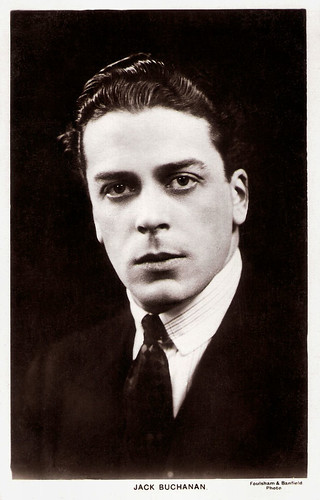
British postcard by Real Photograph in the Picturegoer Series, London, no. 227. Photo: Foulsham & Banfield.
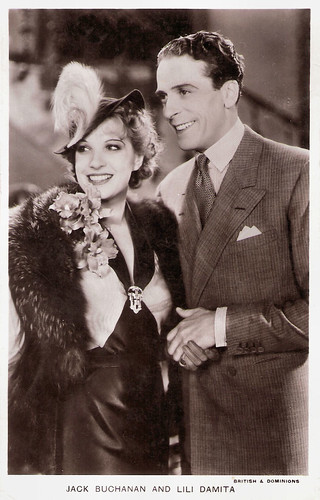
British postcard in the Film Partners Series, no. P 181. Photo: British & Dominions. Publicity still for Brewster's Millions (Thornton Freeland, 1935) with Lily Damita.
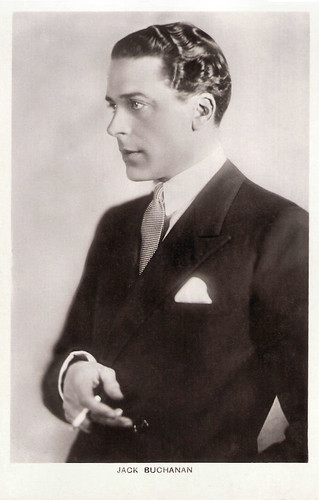
British postcard in the Picturegoer Series, London, no. 227a.

British postcard by De Reszke Cigarettes, no. 35. Photo: British & Dominions.
Sources: Andrew H. Spicer (Oxford Dictionary of National Biography), Victoria and Albert Museum, Helensburgh Heroes, Wikipedia, and IMDb.
This post was last updated on 21 August 2023.
No comments:
Post a Comment